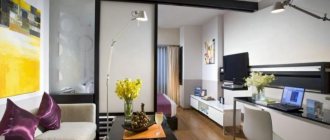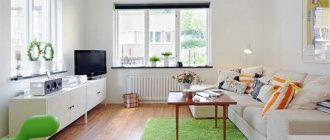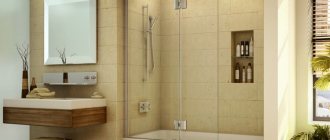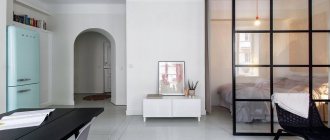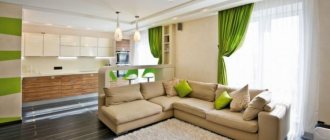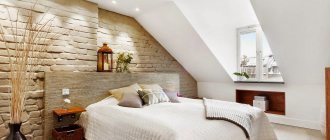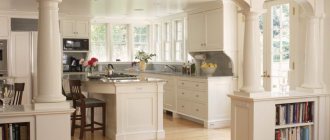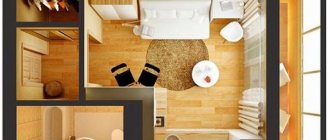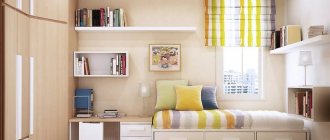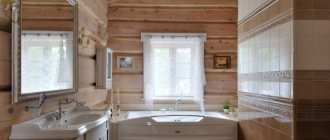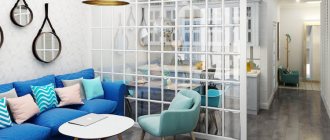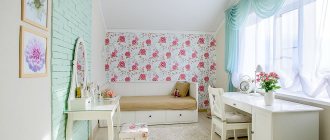Not many people are happy with the layout of typical city apartments. Small, cramped rooms and living spaces are not functional or comfortable. That is why, more and more often, during renovations, owners decide to demolish non-load-bearing walls. As a result, you get a spacious room, which, for example, can serve as a dining room, living room and bedroom. Installing plasterboard partitions to zone the space in the room will help to draw visual boundaries between areas with different functions. By choosing their appearance wisely, you can emphasize the most advantageous advantages of the room layout.
Ways to divide a room
There are many options for dividing a room into two or more functional areas. Choosing one of them depends on your design ideas, budget and room size.
- For those who want to avoid large-scale construction work, we can recommend using decorative elements such as an aquarium, columns, a fireplace or its imitation to zone the room.
- Recently, it has become fashionable to install arched partitions in rooms, because they take up minimal space on the floor and walls, and cope perfectly with the function of dividing space.
- The idea of placing small cabinets and mezzanines in the internal cavities of the arches is rational and interesting.
- Often the room is divided using podiums and multi-level ceilings, which raise or, conversely, lower the level of one of the surfaces.
- You can designate the different functional purposes of zones in the room by simply painting the walls of the room in different colors or pasting them with multi-colored wallpaper, thus outlining the boundaries.
- The most common and effective way is to install partitions.
Zoning planning
As you can see in the photo, a small plasterboard structure, correctly installed in a small apartment, created two full-fledged rooms. Without zoning, it would be one room with large dimensions, half of the space of which would simply remain unused. Therefore, plasterboard partitions do not at all reduce the free space in the apartment, but only increase it.
There are two types of zoning, for different situations - open and closed.
In cases with open zoning, only a false partition is used in order to carry out the division only visually. Access from one room to another remains completely open, and only a partial structure separates them.
A closed partition is precisely a closed wall that has an arched or, more often, doorway. Unlike an open partition, it not only visually, but also actually divides one large room into two small ones.
Advantages of indoor partitions
The decision to install a partition inside the room has many advantages:
- Even if there are several people in the room at the same time, opaque partitions will allocate personal space to everyone.
- A decorative partition will visually separate each of the functional areas of the room.
- Such a design move will solve the problem of the lack of living rooms in the apartment, without the need to make a radical restructuring.
USEFUL INFORMATION: How to properly hang a 5-part modular picture
- The presence of partitions allows you to decorate each zone of the room in your own individual style.
- With proper selection of the design, shape and size of the partition, you can correct the shortcomings of the room layout. On the Internet you will find many photos confirming this statement.
- Despite the fact that partitions divide the space of a room into several smaller zones, by choosing a mirror or glass version of the barrier, you can visually enlarge the room.
- With a stylish modern design of partitions, the overall appearance of the room is significantly improved.
Open zoning
This type of zoning may include decorative partitions that are equipped with a variety of niches, columns and other plasterboard structures. Such zoning can serve not only practical purposes, but also become an excellent decoration for the apartment.
There are several design ideas for partitions for open zoning:
- A decorative open partition can separate the bedroom and living room. Such a partition can simultaneously become a wall for creating a false fireplace or some other decorative plasterboard structure on the bedroom side.
- A partition installed between rooms such as the bedroom and living room may include a special niche for installing a TV. This niche can be an excellent decorative solution for both rooms. So, on one side of the partition you can install shelves, and on the other you can come up with a decorative design that decorates the bedroom.
- Partitions are often equipped with shelves that go right through the wall. On such through shelves you can install a terrarium or an aquarium, which will decorate both rooms at once.
- In addition to useful solutions, a partition is often created as a purely decorative element. Such a partition can be completely transparent. It won't serve any practical purpose, but it looks pretty good from a design point of view. Such partitions are often equipped with various lighting elements, curly shapes cut from plasterboard sheets and other original solutions.
With open zoning, the partition can even be located in the middle of the room, dividing it as if into two zones that are not separated from each other. This can be either a design decision or a practical division of the room.
Why drywall?
The choice of options and materials for arranging partitions in rooms is quite large, from glass to ornamental plants. However, judging by the experience of modern construction, the most common when carrying out redevelopment and zoning of residential premises are plasterboard partitions, which have replaced brick and wooden walls due to their significant advantages:
- Unique properties of drywall. This material is environmentally friendly and absolutely safe for human health. Special treatment increases its resistance to moisture and fire. By combining gypsum plasterboard with mineral wool, you will achieve a significant soundproofing effect in the room. Its shape can be easily changed. To do this, the sheet is wetted with water and given the necessary shape, which is retained even after drying. The surface of this material is perfectly flat, which allows the use of almost any finishing options and partitions.
- Simplicity and speed of installation. Even a person with minimal construction skills can carry it out. If you decide to change the location of the partition in the room, you can easily dismantle it and move it to a new location.
- Between the plasterboard sheets you can hide all the necessary communications (electrical wiring, cables, sewerage, water supply).
- The cost of plasterboard structures is very low. At the same time, their installation will require minimal energy consumption and will cost virtually no noise or debris.
False wall
A false wall is the most common type of partition. It is made of plasterboard so it can take any shape.
- easy installation;
- environmental friendliness;
- shielding noise from devices;
- variety of forms;
- low cost.
- shading areas of the living room;
- relatively rapid wear under the influence of moisture;
- fragility of the material;
- need for additional decor.
How to mount a frame for a partition
The design of plasterboard partitions used to zone space in a room may vary, but the process of their installation follows a typical pattern:
- Using a tapping cord, the future partition is marked in all planes. The correctness of the markings is checked using a level and plumb lines.
- A horizontal guide profile is attached to the floor and ceiling, onto which soundproofing tape is pre-glued. Fastening is carried out using dowels, their installation step is 50 cm.
- Next, work begins on securing the vertical rack profile. The recommended distance between the racks is 60 cm. The first of them is installed close to the load-bearing wall. In order for the structure being built to be stable, the racks must be installed in such a way that they extend into the guide profile by at least 2 cm. The profiles are secured to each other using self-tapping screws.
USEFUL INFORMATION: Plasterboard ceilings for a children's room (8 photos)
Original design ideas
Photos of the most unusual design ideas.
A shortened, low plasterboard zoning model that does not reach the ceiling has a more lightweight appearance, due to which it is also simple and easy to divide the room and introduce certain artistic accents into it.
The photo shows a bedroom interior with a low partition made of gray plasterboard.
A partition with niches and shelves filled with various decorative little things functionally separates or separates the space, creates an aesthetic design and creates a rather unboring design.
The photo shows a bedroom interior with a black plasterboard partition decorated with niches.
With the help of windows, you can visually add additional light, volume and space to the room, correct some architectural shortcomings and give the room coziness and at the same time a certain exclusivity.
Openwork false partitions, thanks to their light and elegant appearance, add special color, elegance and luxury to the environment.
A plasterboard structure, decorated with transparent, frosted, colored, patterned or stained glass, is a very elegant partition that brings special chic, charm and beauty to the interior.
The photo shows a Scandinavian-style studio with a plasterboard partition combined with glass.
Illuminated structures allow you to create a certain semantic central accent in the space and, due to the light pattern, neutralize some of the shortcomings of the redevelopment.
Covering the partition frame
Installing a plasterboard partition in a room is absolutely not a troublesome process. The first thing you need to do to cover the frame is to prepare a gypsum board of the required size. The source material should be marked and cut using a construction knife. If the sheet has holes for sockets, they are cut using special attachments for a drill.
The erected frame of the partition is sheathed according to a pre-planned pattern in a checkerboard pattern. Fastening occurs using self-tapping screws in increments of 20–25 cm. On the Internet you will find many photos showing various design options for straight and curved partitions. A good example of an interesting solution is the following photo.
Glass blocks
You can separate the kitchen from the living room using square glass blocks. In the skillful hands of a designer, refracted light can add chic to a room. But this is not all the advantages of glass blocks. They create good sound and heat insulation. Multi-colored blocks give an elegant look to the room.
Glass is a rather fragile and expensive material. Without additional elements, such blocks only aggravate the situation in the living room.
We increase the sound insulation of structures
When zoning a room using a partition, do not forget to take into account such an aspect as sound insulation. This is achieved using fiberglass boards or mineral boards with a synthetic base.
The noise insulation layer is installed after completing the installation of the sheathing on one side of the frame. To do this, the insulation is cut into pieces of the appropriate size and installed in cells located between the frame and the profile. Please note that the thickness of the insulation should not exceed the thickness of the profile. After the insulation is placed, the sheathing is completed. If there are gaps between the partition and the wall, they should be sealed with foam. This way you will achieve improved sound insulation performance.
Shelving
The shelves will fit perfectly into the interior of any living room. They serve not only as a decorative element, but are also used to store books, vases and other trinkets. Shelving adds coziness and does not overload the atmosphere of the living room. But at the same time, they let in all the smells and noises from the kitchen. Without constant cleaning, shelving can ruin the aesthetic appearance of the room.
How to hide the seams left between plasterboard sheets?
GKL joints are usually sealed using one of the following methods:
- Gluing the seams with a sickle mesh and applying a special putty for seams to it.
- Filling seams, reinforcing with paper tape.
To treat the entire surface, gypsum putty is used, after it dries, sanding is performed.
The variety of possible options for partitions, ease of installation in a room, and a wide range of possible finishing options make them one of the most popular options for interior design of rooms.
Furniture elements
Various pieces of furniture can be used to separate the kitchen from the living room. It could be an arch, a closet, a sofa, a table. The advantages of such redevelopment are cheap, mobile and non-standard design. Zoning is carried out using improvised pieces of furniture, which can be rearranged from place to place at any time.
Material selection
Before purchasing this or that design, you need to analyze the parameters of the room. What size and shape is the kitchen? Is there a need for additional lighting? Are there small children living in the family? Such a detailed analysis will help to weed out a large number of unsuitable options, saving time, money and nerves.
Drywall
Due to its low cost and ease of use, drywall is the most popular building material. It is used in its pure form. So in combination with other elements. False walls and arches are made from plasterboard. For additional decoration, the surface can be plastered. Paste it with wallpaper, hang a picture or a family photo.
Tree
This “warm material in properties and appearance speaks for itself. Wood will fit perfectly into any style of room. Eco-friendly, reliable and versatile material is used for the manufacture of stands, shelving, and sliding partitions.
Chipboard is most often used as a decorative substitute for natural wood. The only outstanding feature is the low price. Chipboard is widely used in cabinet furniture, shelving and sliding partitions.
Which is better: heated floors or radiators?
Warm floorBatteries
Glass
This material should be used if you need not only to divide the room, but also to brighten the room. The effect of broken light visually expands the space. It is used for the manufacture of glass blocks, the inside of partitions, decorative stained glass windows and other pieces of furniture.
Plastic
This practical material most often appears as decorative details and inserts. Frames, chairs, shelving, parts of stands, etc. are made from it. But it is better not to use it in large quantities in the kitchen.
Advice! Dividing partitions can be decorated with metal, fabric, and pots with live plants can be placed.
